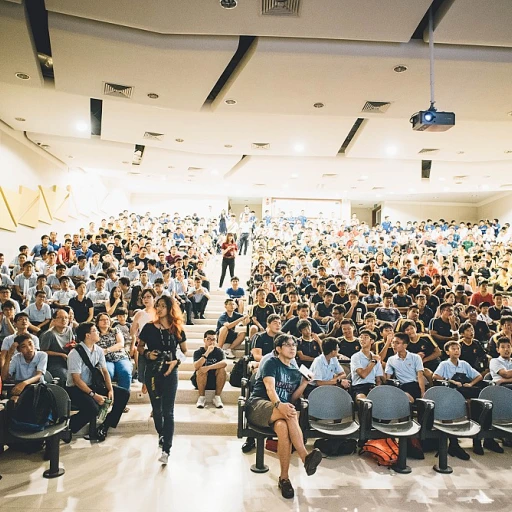Understanding the Evolving Role of HR Leaders in Tech-Driven Changes
In the age of digital transformation, the role of Chief Human Resources Officers (CHROs) has transformed significantly, reflecting broader trends in the business landscape. As organizations increasingly leverage digital tools and platforms, CHROs are no longer confined to traditional HR tasks. Their roles have expanded to become pivotal in guiding and implementing digital strategies that align with the organization's goals.
CHROs must now balance their expertise in managing human capital with an understanding of emerging technologies. This intersection between human resources and technology presents an opportunity to drive organizational growth and innovation. By collaborating with other C-suite executives, CHROs play a crucial role in steering digital initiatives that span from recruitment processes to workforce development.
To effectively navigate this shift, CHROs need to:
- Foster a culture of continuous learning and digital fluency among employees, ensuring their adaptation to new tools and methods.
- Align HR strategies with technological advancements to enhance productivity and maintain a competitive edge.
- Engage in data-driven decision-making to predict workforce trends and address potential challenges proactively.
Additionally, CHROs are tasked with enhancing the employee experience through digital tools, which we explore further
here. This involves not only selecting and implementing the right technologies but also ensuring these tools contribute meaningfully to an employee's journey within the company.
As we continue to see rapid technological change, CHROs must stay ahead by understanding digital trends and incorporating them into their strategic planning. This requires continuous adaptation and a willingness to innovate within the HR function itself.
Leveraging Data for Strategic Decision Making
Data-Driven HR Strategies
In the digital age, the role of Chief Human Resources Officers (CHROs) has expanded beyond traditional HR functions to include leveraging data for strategic decision making. This transformation requires a fundamental shift in how HR departments operate, with a strong emphasis on data analytics. By effectively utilizing data, CHROs can make informed decisions that align with business goals and enhance organizational performance.
One of the main advantages of using data in HR is the ability to identify trends and patterns that were previously inaccessible. This can range from analyzing employee turnover rates to understanding workforce demographics. By having this information at their fingertips, CHROs can devise strategies that are not just reactive, but proactive. This approach supports the development of a more agile and resilient workforce.
Moreover, data analytics empowers HR leaders to forecast future workforce needs, which is essential for long-term planning. For instance, predictive analytics can provide insights into potential talent shortages, allowing organizations to develop targeted recruitment and retention strategies. This is crucial in maintaining competitive advantage in today's rapidly evolving marketplace.
Furthermore, data-driven strategies facilitate the creation of tailored training programs that enhance employee skills and competencies. By understanding employee strengths and areas for improvement, CHROs can allocate resources more efficiently and drive continuous learning within the organization.
Overall, the integration of data in HR not only supports strategic decision making, it also transforms the HR function into a key player in driving business success. As digital transformation continues to progress, CHROs must remain committed to harnessing the power of data, making it a central component of their strategic toolbox.
Transforming the Employee Journey
Digital transformation stands at the core of modernizing the employee journey, an essential task for Chief Human Resources Officers (CHROs). Embracing digital tools not only streamlines HR processes but also plays a crucial role in enhancing the overall employee experience.
Modern employees expect seamless interactions with HR services. Here's how digital tools can make a significant difference:
- Personalized Onboarding: By leveraging digital platforms, CHROs can offer tailored onboarding experiences. Automated onboarding systems ensure that new hires are quickly integrated into the company culture, receiving relevant training and resources without delay.
- Efficient Communication: Digital communication tools foster better interaction between employees and HR. Utilizing platforms such as chatbots and AI-driven communication software ensures that employee queries are addressed promptly, increasing satisfaction and engagement.
- Growth and Development: Implementing learning management systems enhances professional development opportunities, enabling employees to engage in remote or self-paced learning modules. Such platforms support career advancement and skill enhancement, aligning with employee aspirations.
Additionally, data-driven insights, as highlighted in the strategic decision-making process, empower CHROs to tailor policies and practices that cater to the diverse needs of the workforce. This proactive approach not only boosts morale but also aligns with broader organizational goals.
For CHROs eager to embrace technology, the
power of people analytics cannot be overstated. Analytics help in identifying key areas for improvement, measuring employee satisfaction, and even predicting turnover trends. This foresight allows organizations to take corrective actions and enhance employee contentment.
Ultimately, by integrating digital tools into the HR strategy, CHROs can deliver a more personalized, efficient, and future-ready employee experience, vital for attracting and retaining top talent.
The Intersection of Human Resources and Technology
Blending Human and Technological Resources
In today’s fast-paced digital landscape, the intersection of human resources (HR) and technology is where innovation truly takes flight. Chief Human Resources Officers (CHROs) find themselves at the frontline of this fusion, tasked with the complex challenge of integrating technological advancements into the heart of HR functions.
One of the primary roles of a CHRO in digital transformation is to harmonize the balance between human insights and technological capabilities. This involves reimagining traditional HR processes through the lens of technology, ensuring that human touch is maintained while leveraging digital efficiencies.
Technological Tools Empowering HR
The advent of digital tools offers transformative potential for HR. Tools such as Artificial Intelligence (AI) and machine learning are no longer futuristic concepts but practical solutions for enhancing recruitment, employee engagement, and performance evaluations. CHROs are in a unique position to guide the strategic implementation of these technologies to maximize their benefits.
- Recruitment and Talent Acquisition: AI can streamline the hiring process by analyzing candidate data more efficiently and without bias.
- Employee Engagement: Digital platforms create more effective communication channels, fostering a culture of innovation and transparency.
- Performance Management: Advanced analytics provide deeper insights into employee performance, helping to align individual goals with organizational objectives.
Navigating Challenges
Despite the numerous advantages, integrating technology into HR also presents significant challenges. Data security, privacy concerns, and the need for employee upskilling are pivotal issues that CHROs must address.
By creating comprehensive training programs and prioritizing digital literacy, CHROs can lead their organizations to not only embrace digital tools but use them to cultivate a more agile and resilient workforce.
Collaboration Across Departments
At the core of a successful digital transformation strategy is cross-departmental collaboration. CHROs must work closely with IT and other departments to ensure that technological integration aligns with the broader organizational vision. This collaboration can spark innovative solutions and foster a culture of continuous improvement.
Through combining the nuanced understanding of workforce needs with advanced technology, CHROs can drive forward a digital transformation that is as human-centric as it is innovative, setting the stage for sustained success in the ever-evolving business landscape.
Case Studies: Success Stories from Global Companies
Case Study: A Global Tech Giant's Transformation
One of the most compelling examples of a successful digital transformation led by a CHRO comes from a leading global tech company renowned for innovation. This organization recognized the crucial role of human resources in steering digital change.
The company embarked on an initiative to harness data for strategic decision-making, fundamentally altering how they approached employee management. They implemented advanced HR analytics tools, allowing the CHRO and team to pinpoint areas for improvement with precision. This data-driven approach laid the groundwork for tailored talent strategies and significantly enhanced workforce efficiency.
Moreover, the organization placed a strong emphasis on enhancing the employee experience through digital tools. By integrating mobile platforms and collaborative technologies, employees gained seamless access to training, wellness resources, and peer collaboration platforms. This boost in engagement drastically improved job satisfaction and retention rates.
Lessons from the Financial Services Sector
A major player in the financial services industry also offers valuable insights into digital transformation driven by human resources. Their CHRO spearheaded a shift towards a more agile work environment, leveraging technology to break down traditional silos within the company.
Incorporating digital HR platforms facilitated smoother cross-departmental collaboration and led to innovations in product development and customer service. The focus on enhancing the intersection of human resources and technology empowered employees to contribute more effectively and efficiently.
Through these examples from tech and financial services, it's evident that CHROs can effectively drive digital transformation, leading to substantial strategic advantages for their organizations. These stories highlight the integral role of CHRO leadership in navigating and capitalizing on technological advancements.
Future Trends in CHRO Strategies
Adapting to New Skill Requirements
The future of CHRO strategies in the realm of digital transformation will demand an adaptive approach to developing and acquiring new skill sets. With technology continuously advancing, it’s essential for CHROs to ensure their workforce remains competitive. This involves not only recruiting talent that possesses cutting-edge digital skills but also investing in upskilling existing employees. Aligning human resource initiatives with technological advancements creates a culture of continuous learning and innovation.
Building a Resilient Workforce
As part of the ongoing digital transformation journey, CHROs are tasked with fostering resilience within the workforce. Hybrid work environments, virtual collaboration, and AI-driven tools are becoming the norm. Preparing employees to adapt to these changes is vital for maintaining productivity and engagement. It’s about building a workforce capable of withstanding fluctuations in the industry and technology-driven disruptions.
Navigating AI and Automation
One of the most significant impacts on CHRO strategy will be the integration of AI and automation. These technologies offer immense potential for improving HR operations and freeing up human resource professionals to focus on strategic initiatives. Understanding how to balance automation benefits while ensuring a human touch in employee interactions will be key to an effective CHRO strategy. Embracing these technologies can greatly enhance decision-making processes, as discussed earlier.
Data-Driven HR Strategies
The future of CHRO strategies is undoubtedly data-centric. Leveraging data and analytics to inform HR strategies can lead to more strategic decision-making, as previously highlighted. The ability to collect, interpret, and act on data insights will increasingly differentiate successful organizations from their peers. This data-driven approach will empower CHROs to anticipate workforce trends, optimize talent management, and personalize the employee experience.
Evolving Corporate Culture
Digital transformation also brings about changes in corporate culture. As technology permeates every aspect of work, CHROs must champion the evolution of company culture to remain aligned with digital advancements. Fostering an inclusive, agile, and innovative culture will help organizations adapt swiftly to changes and harness new technologies effectively. Creating a cohesive environment that embraces digital transformation can be a significant competitive advantage in the coming years.







